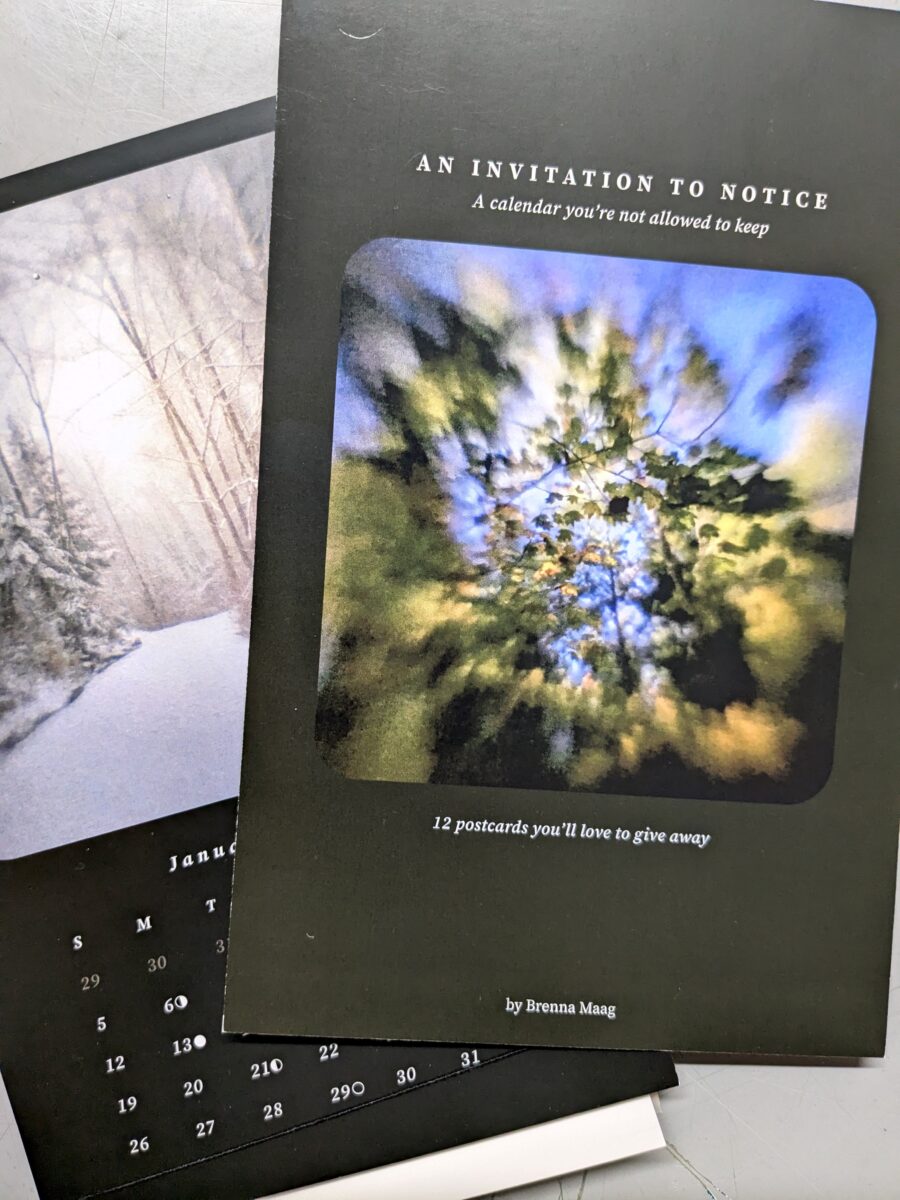
“A calendar you are not allowed to keep” seems the perfect exchange for Reading the Migration Library publications, which you are not allowed to buy. The calendar, An Invitation to Notice, is an innovative desk calendar that artist Brenna Maag has just produced and released in an edition of 400. That is a big number for an item that requires hand-assembly, I have to note, given the current pile of un-assembled RML3 components currently sitting on my and Ruby Lewis’s (push pull press) worktables. The exhausted Maag hand-delivered my purchased copy of a completed desk calendar yesterday, but then exchanged another copy for copies of RML3 Undercurrents and Folds publications.
An Invitation to Notice is an artist publication that features twelve exposures from Brenna Maag’s Camera Illumina, an interactive camera obscura that the artist uses to observe and relate to non-built environments around her and others. The camera has appeared numerous times in public parks and events in Abbotsford, Burnaby, and Mission, British Columbia in recent years. Maag describes how the simple, passive exposure apparatus has given her opportunities to relate to the natural world around her, and how she hopes it will do the same for those who visit and view through the camera at public events,
Camera Illumina is an exploration of what it means to live in a reciprocal relationship with the land. I first encountered this notion in the book Braiding Sweetgrass: Indigenous Wisdom, Scientific Knowledge, and the Teachings of Plants by the Potowatami botanist Robin Wall Kimmerer. She describes a way of being that is ‘rooted in intimacy with a local landscape where the land itself is the teacher’. Reading this made me rethink my relationship to my home, the ancestral land of the Stó:lō people. As a settler artist I am trying to create a deeper relationship to where I live and unlearn my colonial view of ‘nature’ as separate from me.” Brenna Maag
The pin-hole method of creating an inverted live image used in camera obscuras of all sizes and scales, can be imagined as a pre-technology version of photography, I heard Trudi Lynn Smith and Kate Hennessy discussing at their recent artist talk at the exhibition, Becoming Anarchival (Gallery 881). As anthropologists and artists they were musing about how the pin-hole method of capturing images would have been noted by humans encountering fluttering leaves on trees long before the machinery of photography appeared. Knowing Maag’s previous work well, I can see how her art has held to account eighteenth century technology and science. In the work Taxonomy she appropriated Linnaeus’s binomial nomenclature for a collection of over 100 hand-crafted doilies. They were documented by solarized exposures which she arranged in categories on the wall. In Conservatory more than 700 of those doilies were mounted onto a dome viewing room, something like an eighteenth century planetarium.
The calendar is like a residual document of the in-person intimate encounters of Camera Illumina and the alternate exposures it offers of the local environment. Each month of the calendar features an image captured by setting a digital camera or phone inside the viewing area. But more than a picture calendar for marking time, An Invitation to Notice follows Maag’s practice of gentle interventions through art and inviting people to take an action. That action is to take each of the loose calendar cards and turn them into a post card for sending. This part of the project is inspired by her recently passed father who left a legacy of postcards that Maag received as a child. Once the current labour dispute at Canada Post is resolved (after some of the 2025 months have come and gone -?!), these image gems can be further distributed in this way.
When we met yesterday Maag, recalled how mail art for both of us has been a methodological through-line in our work. I recall being part of an exhibition (Peace Tense) that included her postcard action The Peacework Project alongside other works that challenged military action in Afghanistan and Iraq twenty years ago. Kriss Boggild, who was also part of Peace Tense has recently been lending a hand in binding RML3 publications, so the kinship surrounding our art practices is continuing.
I am wondering now, what will the 2025 postcards say once they migrate?



